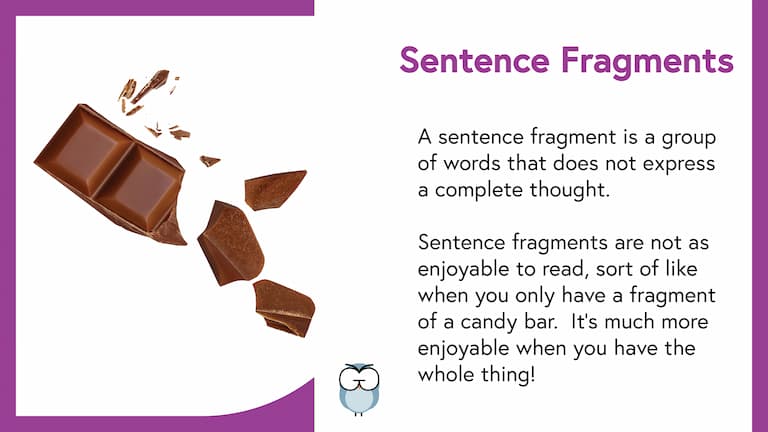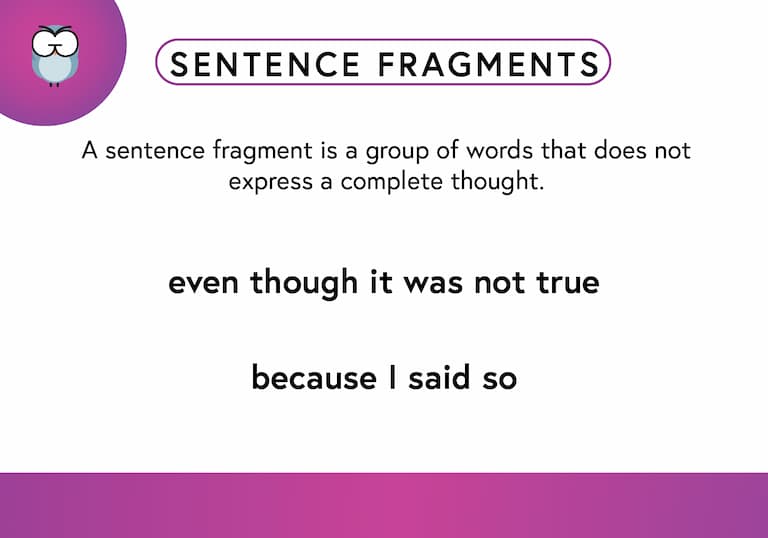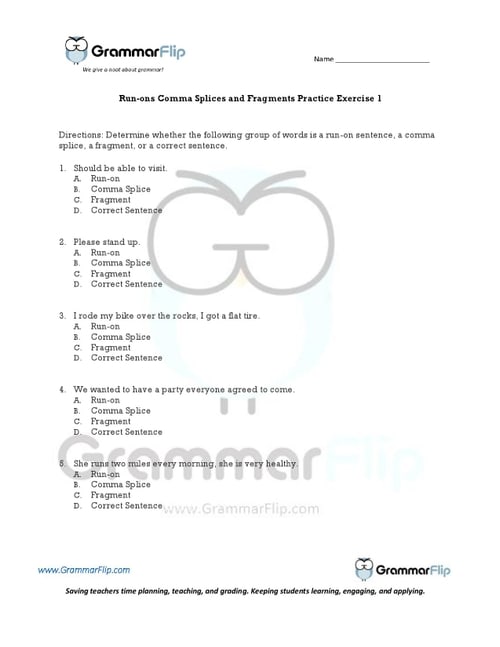What is a Sentence Fragment?
A sentence fragment is a group of words that does not express a complete thought.
Some examples of sentence fragments would be the following:
The house with the red door.
To the nature park.
But that was not true.
Because I said so.
Long-Form Videos: Sentence Fragments
Long-form instructional video lessons allow students to engage with grammar concepts in more depth and detail.
This format provides students with a stronger foundation and a more comprehensive understanding of sentence fragments.
Short-Form Videos: Sentence Fragments
Short-form videos are an excellent way to review grammar concepts. Our two-minute instructional videos help students review the concept of sentence fragments to further solidify their understanding.
Memorable Images: Sentence Fragments

The use of images to connect visual cues with concepts makes it simpler for students to grasp and remember key ideas. GrammarFlip’s memorable images create visual associations that make sentence fragments more engaging and easier to retain.
Definition Cards: Sentence Fragments
Definition cards reinforce grammar concepts by providing clear and concise explanations that students can easily reference for quick review and better retention. GrammarFlip’s definintion cards help students review the concept of sentence fragments to further solidify their understanding.

More About Sentence Fragments
Once you understand what a sentence fragment is, there’s actually a time to use sentence fragments in your writing and a time to avoid them. Let’s look at some reasons for avoiding sentence fragments and some reasons for when it might actually make sense to use them in your writing.
Reasons to Avoid Sentence Fragments in Your Writing
Because sentence fragments are incomplete thoughts or ideas, they can definitely leave your reader a bit confused and should be avoided all costs. Take the following sentence fragment for example:
To the store.
Okay – what about the store? What are you trying to tell your reader? You went to the store? She went to the store? No one went to the store? This fragment is missing a subject and a verb, and therefore it’s not clear what you’re trying to convey.
When you’re just starting out as a writer, your teacher may tell you not to write in sentence fragments, and that’s perfectly fine. Learn the rules before you can break them. There will come a time, however, when you can bend the rules regarding sentence fragments.
Reasons You Might Actually Use Sentence Fragments in Your Writing
As you probably already know, we don’t speak to one another in perfect grammatically correct sentences. And guess what – that’s okay! There’s a time and a place and a genre in which to use sentence fragments in your writing.
Narrative Writing is a great example of when you might actually employ the use sentence fragments. When you’re relaying a story, you tend to be more conversational in tone, or if you have dialogue in your story, you want to capture the true way that people speak to one another. Writing with sentence fragments is a great way to reveal character and to come across more casual in your writing voice. Notice the use of sentence fragments in the exchange below:
Dina: “Where’d you go today?”
Alvin: “To the store.”
Dina: “When did you get back?”
Alvin: “About seven o’clock.”
Persuasive Writing is another genre of writing in which sentence fragments can work to your advantage. When you’re tyring to persuade or convince someone of something, using clear and direct language can work to your advantage. Take the following group of sentences/fragments as an example:
We must avoid this. At all costs. Period.
Notice that last two are fragments, but that’s okay. You’re goal is to separate these two fragments from the independent clause to drive home a point. They stand out more to your reader, and that’s a great stylistic use of sentence fragments.
Just remember, knowing when to avoid sentence fragments is just as important as knowing when you can use them. Be sure you understand the difference.
Other writing errors such as run-on sentences and comma splices are important to avoid as well, so be sure you are familiar with those.
Download a Free Worksheet on Sentence Fragments!
Click the image below to download your free worksheet on sentence fragments!

Need a grammar program that provides the instruction and grading for you?
Explore More GrammarFlip Lessons!
Parts of Speech lessons provide the building blocks of grammar. GrammarFlip covers these topics in detail to ensure a solid foundation is built. First time learners and students seeking to review the parts of speech can both benefit from the instructional videos and slide show reviews.
Parts of the Sentence lessons are critical for understanding how the parts of speech function in language construction. From the basic to the advanced, these lessons will cover a wide range of grammar topics that can be used in any grade level or classroom.
Mechanics and Usage lessons equip students with the necessary skills to communicate clearly to all audiences. With a focus on the application of these concepts in student writing, these lessons tie together both simple constructions of grammar as well as the more complex such that any age or skill level of student will benefit.


